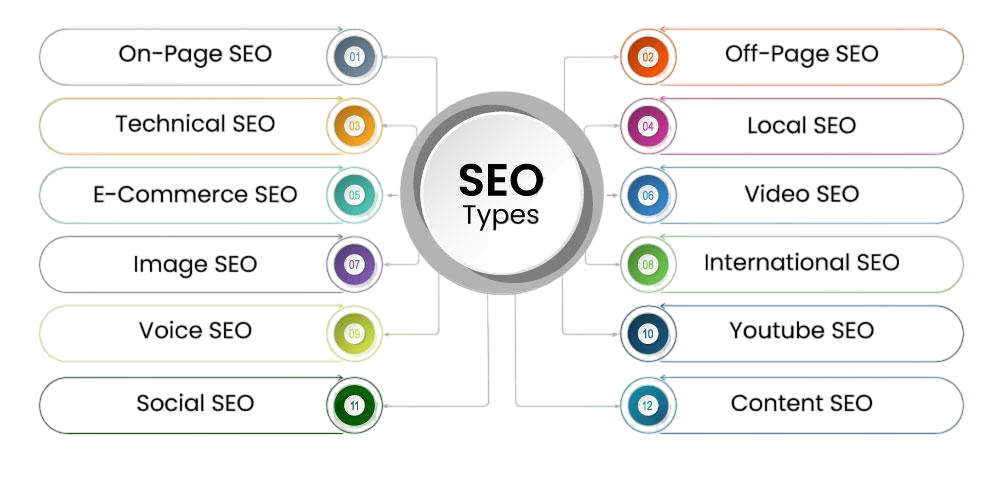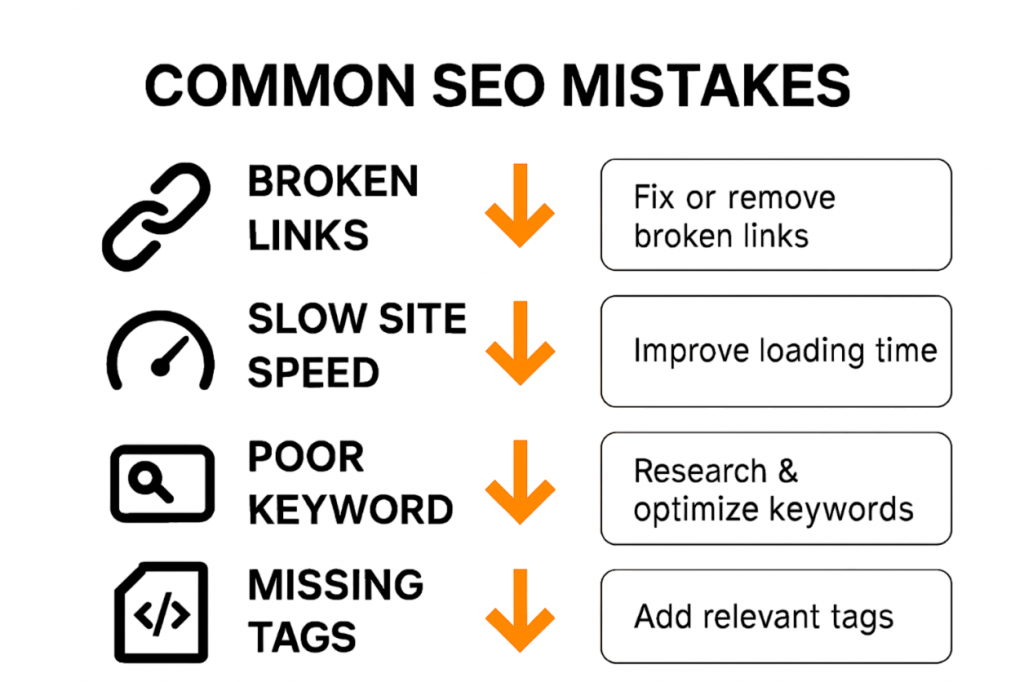
- Introduction to SEO
- How Search Engines Work
- Why SEO is Important
- Types of SEO
- Keyword Research: The Foundation of SEO
- On-Page SEO Best Practices
- Off-Page SEO Strategies
- Technical SEO Essentials
- Content Optimization for SEO
- Measuring SEO Success: Tools and Metrics
- Common SEO Mistakes to Avoid
- SEO Trends and Future Outlook
- Conclusion
Introduction to SEO
Search Engine Optimization, or SEO, is the process of enhancing your website’s visibility on search engines like Google, Bing, and Yahoo. When done right, SEO helps your website rank higher in organic (non-paid) search results, driving more targeted traffic and potential customers to your site core principles covered in Digital Marketing Training, where learners master keyword strategy, technical optimization, and content alignment to build sustainable visibility and attract qualified leads through organic search. This tutorial will walk you through the fundamentals of Search Engine Optimization, the strategies you need to implement, and the tools you can use to track and improve your performance.
Ready to Get Certified in Digital Marketing? Explore the Program Now Digital Marketing Online Training Offered By ACTE Right Now!
How Search Engines Work
To understand Search Engine Optimization, you first need to know how search engines work. Search engines use complex algorithms to crawl, index, and rank web pages based on relevance and quality fundamentals explained by Digital Marketing Experts, who break down how bots discover content, how indexing structures the web, and how ranking algorithms evaluate signals like keyword relevance, site authority, and user experience to determine visibility in search results.
Crawling
Search engines send out bots (also called spiders or crawlers) to discover pages on the internet.
Indexing
Once a page is discovered, it’s analyzed and stored in the search engine’s database.
Ranking
When a user enters a search query, the engine evaluates all indexed pages and ranks them by relevance, quality, and authority, showing the most useful results first.
Why SEO is Important
- Organic Traffic: SEO helps bring free, relevant visitors without paid advertising.
- Credibility and Trust: High search rankings often indicate authority and trustworthiness.
- Better User Experience: SEO involves optimizing your website’s usability.
- Cost-Effective Marketing: Compared to paid ads, SEO offers long-term benefits.
- Competitive Advantage: Businesses with strong SEO tend to outperform competitors online.
- Title tags, meta descriptions
- Header tags (H1, H2, etc.)
- Keyword placement and density
- URL structure
- Internal linking
- Image alt texts
- Link building
- Social media marketing
- Influencer outreach
- Guest blogging
- Website speed and performance
- Mobile-friendliness
- XML sitemaps
- Robots.txt
- Structured data markup (Schema)
- HTTPS security
- Build Quality Backlinks: Focus on links from authoritative and relevant websites.
- Guest Posting: Write for other blogs to get backlinks and exposure.
- Social Media Promotion: Share content to increase visibility and traffic.
- Engage with Online Communities: Participate in forums, Q&A sites like Quora.
- Monitor Your Brand Mentions: Reach out to sites that mention you but don’t link back.
- Mobile Optimization: Ensure your site is responsive and works well on all devices.
- Improve Site Speed: Use tools like Google PageSpeed Insights to identify bottlenecks.
- Create XML Sitemap: Submit to Google Search Console for better indexing.
- Use Robots.txt Wisely: Prevent crawling of duplicate or irrelevant pages.
- Implement HTTPS: Secure your site with SSL certificates.
- Use Structured Data: Help search engines understand your content better.
- Keyword Stuffing: Overusing keywords makes content unnatural and penalized.
- Ignoring Mobile Users: Mobile-first indexing means poor mobile experience hurts rankings.
- Duplicate Content: Causes confusion for search engines.
- Ignoring Technical SEO: Site speed, broken links, and crawl errors can limit rankings.
- Not Tracking Performance: Without data, you can’t improve.
- Buying Low-Quality Links: Can cause penalties.
- Poor User Experience: Difficult navigation, intrusive ads, and slow loading times.
- Voice Search Optimization: Growing use of voice assistants changes keyword strategy.
- AI and Machine Learning: Search engines get smarter in understanding content intent.
- Mobile-First Indexing: Mobile experience is now the priority.
- Video SEO: Videos are increasingly important for engagement and rankings.
- Core Web Vitals: Google’s new ranking factors focusing on page experience.
- E-A-T Principle: Emphasis on Expertise, Authority, and Trustworthiness in content.
To Explore Digital Marketing in Depth, Check Out Our Comprehensive Digital Marketing Online Training To Gain Insights From Our Experts!
Types of SEO
SEO can be broadly divided into three main categories:
On-Page SEO
Refers to optimizing content and HTML source code of individual pages.

Off-Page SEO
Involves external signals to your site such as backlinks, social shares, and brand mentions.
Technical SEO
Focuses on backend optimizations that help search engines crawl and index your site effectively.
Keyword Research: The Foundation of SEO
Effective keyword research is an essential strategy for optimizing digital content. It focuses on understanding the exact terms users enter into search engines. The process starts with brainstorming broad topics within your niche. It also involves using tools like Google Keyword Planner, Ahrefs, SEMrush, and Ubersuggest to find valuable search terms. Successful keyword research isn’t just about identifying keywords it’s about understanding user intent, search behavior, and competitive dynamics, as outlined in Digital Marketing Training, where learners master clustering techniques, performance metrics, and strategic alignment to ensure every keyword supports discoverability, engagement, and measurable business outcomes. It requires a thorough look at search intent to understand whether users want information, are ready to buy, or are targeting specific websites. Marketers need to assess keyword difficulty scores and competitor rankings. They should prioritize long-tail keywords, which offer more specific and less competitive opportunities. The main goal is to map these keywords to existing or new content pages. This ensures they match audience search habits and maximize visibility in search engine results. By following this approach, businesses can create engaging and discoverable content that meets user needs and search patterns.
Looking to Digital Marketing Training? Discover the Digital Marketing Expert Masters Program Training Course Available at ACTE Now!
On-Page SEO Best Practices
To improve your website’s search engine optimization (SEO), implement an on-page strategy that focuses on key technical elements. Start by optimizing title tags with primary keywords while keeping them concise, under 60 characters. Craft compelling meta descriptions that summarize page content clearly within 160 characters. Use header tags wisely, keeping H1 for the main title and H2–H6 for organized subheadings a structural best practice emphasized in Become a Digital Marketing Specialist, where learners master semantic hierarchy, keyword placement, and readability techniques that help search engines interpret content structure while enhancing user experience through clear, scannable formatting. Incorporate keywords naturally throughout your content, focusing on readability rather than forced placement. Create clean, descriptive URLs that are short and include keywords. Build your site’s internal linking structure by connecting relevant pages to effectively distribute link equity. Improve accessibility and SEO by adding descriptive alt text to images. Finally, enhance overall page performance by compressing images and using browser caching. This will ensure a smooth user experience that search engines will recognize.
Off-Page SEO Strategies
Preparing for Digital Marketing Job Interviews? Have a Look at Our Blog on Digital Marketing Interview Questions and Answers To Ace Your Interview!
Technical SEO Essentials
Content Optimization for SEO
In the fast-changing world of digital marketing, quality content is essential for SEO success. By creating valuable and unique content that solves problems and answers user questions, businesses can build strong connections with their audience. Regularly updating content shows search engines that the information is relevant and keeps it fresh and engaging a visibility tactic emphasized in Choose a Career in Digital Marketing, where professionals learn how SEO-driven content refresh cycles improve rankings, signal authority, and support long-term organic growth across evolving digital landscapes. Using multimedia elements like images, videos, and infographics can greatly improve the appeal and understanding of the content. Making the content easy to read with short paragraphs, clear fonts, and smart formatting helps visitors consume and understand the information easily. Adding clear calls-to-action guides users on what to do next. Utilizing user-generated content, such as reviews and testimonials, helps build trust and credibility. This well-rounded approach to content creation not only boosts search engine rankings but also creates a more interactive and engaging digital experience for potential customers.
Measuring SEO Success: Tools and Metrics
Understanding key Search Engine Optimization metrics is essential for success in digital marketing. Several important indicators provide insights into how a website is performing. Organic traffic shows the number of visitors coming from search engines. Keyword rankings display where your pages stand in search engine results pages (SERPs). Tracking bounce rate helps gauge user engagement by showing the percentage of visitors who leave without interacting a diagnostic metric emphasized in Create a Digital Marketing Report, where marketers learn how to interpret bounce trends, correlate them with content relevance and UX signals, and integrate them into performance dashboards to uncover friction points and improve retention across digital touchpoints. Click-through rate (CTR) measures how effective your search listings are. Monitoring the quantity and quality of backlinks gives important signals about domain authority. Conversion rate reflects the success of your digital strategy by showing the percentage of visitors who complete desired actions. To analyze these metrics effectively, digital marketers use tools like Google Analytics for tracking traffic and user behavior. Google Search Console helps monitor site health. Advanced platforms like SEMrush, Ahrefs, and Moz provide in-depth keyword research and competitive analysis. Tools for technical SEO auditing, such as Screaming Frog, help identify potential website issues. PageSpeed Insights measures loading speeds and suggests improvements to ensure optimal site performance. By using these tools and grasping the key metrics, businesses can create data-driven strategies to improve their online visibility and digital marketing effectiveness.
Common SEO Mistakes to Avoid

SEO Trends and Future Outlook
Conclusion
Mastering Search Engine Optimization takes time, effort, and continuous learning. By understanding how search engines work, conducting thorough keyword research, optimizing your site both on-page and off-page, and keeping up with technical SEO, you can steadily improve your site’s search visibility and attract more qualified traffic core competencies covered in Digital Marketing Training, where learners progress from foundational SEO principles to advanced strategies using tools like Google Search Console, SEMrush, and Ahrefs to drive sustainable organic growth. Remember to track your results, avoid common mistakes, and adapt to evolving trends. SEO isn’t a one-time task but an ongoing process that pays off with consistent effort. Ready to start optimizing your site? Begin with keyword research today and take your first step toward SEO success!




